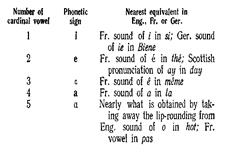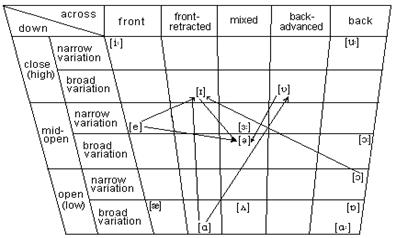Lecture 4. The system of english vowel phonemes
Issues of the lecture:
1) Articulatory and acoustic characteristics of English vowels.
2) The notion of vowel quality.
3) Criteria for English vowels analysis:
a) stability of articulation (the problem of monophthongs, diphthongs and diphthongoids);
b) tongue position (horizontal and vertical movement);
c) lip rounding;
d) checkness;
e) vowel duration/ quality;
f) tenseness
4) Modifications of Vowels in Connected Speech.
Things to pay special attention:
For a learner of English to differentiate between vowels of his mother tongue and the vowel sounds of the study language it is very useful to have a universal classification of all the possible vowel sounds in the world and their articulatory peculiarities. In fact it is hardly possible since
(1) there is no language in the world which (or whose vowel system) is known to all the speakers of all the other languages;
(2) even if such a language (or vocalic system) were chosen it would not contain all the vowel types existing in all the other languages of the world. Consequently, the only way out is to invent such an international standard set of artificial vowels with easily explained and learned tongue and lip-positions and the resulting acoustic qualities, in relation to which the vowel sounds of any real language of the world may be described and classified. If a linguist or language-learner masters these vowels first and then studies the vowels of any real language from their description and classification made with reference to these artificial vowels such a description or classification will become immediately intelligible and useful to him.
The first to think of this idea and materialize it was D. Jones, who devised the system of Cardinal Vowels on an articulatory and auditory basis, which can easily be learned. This system is now accepted by linguists of all countries as an international standard.
Fig. 4. Diagram showing the relations of the chief English vowels to the cardinal vowels.


In spite of the theoretical soundness of the Cardinal Vowels idea and the excellent way in which D. Jones materialized it, its practical application has turned out to be limited only to that field where no comparison with one's mother tongue is possible at all.
As for language-teaching, the Cardinal Vowels practically failed due to the factors which D. Jones himself unwittingly explained in the following words: "The values of cardinal vowels cannot be learned from written descriptions; they should be learned by oral instruction from a teacher who knows them."
D. Jones' cardinal vowels have been recorded on gramophone discs by the author himself for the benefit of the "student who has not access to a teacher familiar with the cardinal vowels."
Language-teaching practice has proved that it is quite possible for any language-learner to master the vowels of a foreign language without previously learning the cardinal vowels. Therefore the latter can nowadays be confined only to purely linguistic descriptive and classificatory work for international use.
Triphthong
A triphthong is a vowel glide with three distinguishable vowel qualities - in other words, it is similar to a diphthong but comprising three rather than two vowel qualities. In English there are said to be five triphthongs, formed by adding [ə] to the diphthongs [eɪ aɪ ɔɪ aʊ əʊ]; these triphthongs are found in the words 'layer' [leɪə], 'liar' [laɪə], 'loyal' [lɔɪəl], 'power' [paʊə], 'mower' [məʊə]. Things are not this simple, however. There are many other examples of sequences of three vowel qualities, e.g. 'play-off' [pleɪəf], 'reopen' [riəʊpən], so the five listed above must have some special characteristic. One possibility is that speakers hear them as one syllable; this may be the case, but there does not seem to be any clear was of proving this. This is a matter which depends to some extent on the accent: many BBC speakers pronounce these sequences almost as pure vowels (prolongations of the first element of the triphthong), so that the word 'Ireland', for example, sounds like [ɑ:lənd]; in Lancashire and Yorkshire accents, on the other hand, the middle vowel ([ɪ] or [ʊ]) is pronounced with such a close vowel quality that it would seem more appropriate to transcribe the triphthongs with [j] or [w] in the middle (e.g. 'fire' [fajə]), emphasising the disyllabic aspect of their pronunciation.
Phonotactics
It has often been observed that languages do not allow phonemes to appear in any order; a native speaker of English can figure out fairly easily that the sequence of phonemes [streŋkθs] makes an English word ('strengths'), that the sequence [bleɪdʒ] would be acceptable as an English word 'blage' although that word does not happen to exist, and that the sequence [lvʊəzg] could not possibly be an English word. Knowledge of such facts is important in phonotactics, the study of sound sequences. Although it is not necessary to do so, most phonotactic analyses are based on the syllable. Phonotactic studies of English come up with some strange findings: certain sequences seem to be associated with particular feelings or human characteristics, for no obvious reason. Why should 'bump', 'lump', 'hump', 'rump', 'mump(s)', 'clump' and others all be associated with large blunt shapes? Why should there be a whole family of words ending with a plosive and a syllabic [l] all having meanings to do with clumsy, awkward or difficult action ('muddle', 'fumble', 'straddle', 'cuddle', 'fiddle', 'buckle' (vb.), 'struggle', 'wriggle')? Why can't English syllables begin with [pw bw tl dl] when [pl bl tw dw] are acceptable?
---------------------------------------------------------------------------------------Literature:
1) Соколова М.А., Гинтовт К.П., Кантер Л.А., Крылова Н.И. Практическая фонетика английского языка: Учеб.для студ.высш.уч.заведений. –М.:Гуманит.изд.центр ВЛАДОС, 2003.- с.85-122.
2) Васильев В.А. Фонетика английского языка. Теоретический курс. - М: «Высшая школа», 1969.- С. 82-98; 190-194.
3) Дикушина О.И. Фонетика английского языка. Теоретический курс. – М.: Просвещение, 1965. – С.56-76.
Table 3. The System of English Vowels

